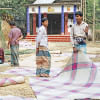An ancient craft struggling to survive

It is distressing to know that yet another traditional craft is on its way to extinction. As per a report by this daily, artisans involved in the century-old craft of making Shital pati (a form of cane mats) in Tangail are struggling to survive due to the shortage of raw materials, rising production costs, and lack of capital. Made from a plant fibre, Shital pati has been popular among the people of Bengal for ages as its surface remains cool even in the hottest weather. It is used primarily in rural households, for sleeping and relaxing purposes. Sometimes, the mats are placed above tin roofs for cooling effects.
Reportedly, around 1,000 families in several villages of Tangail are involved in this craft, who are now facing a threat to their only means of livelihood. With cheaper plastic substitutes flooding the market, the demand for these beautifully crafted mats has gone down, while production issues continue to jeopardise their chance of revival, especially in the face of competition from large corporations. Cane, the primary raw material used in making the mat, is also becoming scarce as there is little investment in this industry. Moreover, the artisans can only earn during the summer months when the demand is relatively high. In the remaining months, they do not have any sales and hence no earnings.
It should be noted that making Shital pati is a slow process as it involves collecting the cane and processing the fibre, after which it is weaved into mats. Most of the weaving is done by women.
Apart from its practical use as a cooling mat during the scorching summer months, Shital pati making is an ancient craft that is part of our heritage. Being environmentally friendly, it has the potential to be very popular in both domestic and international markets if the industry is given the support needed, and it could be a reliable foreign exchange earner. Thus, the arguments in favour of keeping this tradition alive are quite compelling. With proper investment, which would increase cane production and ensure fair remuneration to the skilled artisans, Shital pati has immense value as a sustainable product. Design innovations can also create different uses of the material.
Needless to say, government support is vital to make sure that this industry survives and thrives again. It is encouraging to know that the Bangladesh Small and Cottage Industries Corporation (BSCIC) provides loans to small and medium level entrepreneurs in Tangail. This can be expanded further to include more Shital pati entrepreneurs so that the industry can grow. We, therefore, urge the government to take advantage of the opportunity that it offers, and provide all the financial and marketing support needed to ensure that the artisans of this ancient craft can earn enough to make a decent living and also contribute to the national economy.

 For all latest news, follow The Daily Star's Google News channel.
For all latest news, follow The Daily Star's Google News channel. 





Comments